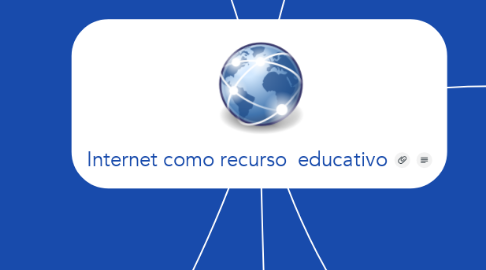
1. Web o bibliotecas
1.1. Ventajas
1.1.1. Simplicidad de acceso
1.1.2. Multimedia
1.1.3. El mundo como una biblioteca unica
1.1.4. Menor trabajo físico
1.2. Desventajas
1.2.1. Alcance
1.2.2. Calidad de información
1.2.3. Saturación de la información
1.2.4. Plagiarismo
1.2.5. Desvíos del tema
2. Entornos virtuales de aprendizaje
2.1. Elementos
2.1.1. Escritorio virtual
2.1.2. Aula Interactiva
2.1.3. Biblioteca
2.1.4. Mi e-Learning
2.2. Tipos de herramientas
2.2.1. Asincrónicas (en tiempo diferido)
2.2.2. Sincrónicas (en tiempo real)
2.3. Características deseables
2.3.1. Plataforma completa y sencilla
2.3.2. Fuerte y sistemática acción tutorial
2.3.3. Interactividad tanto entre tutor y alumno
2.3.4. Trabajo colaborativo
2.3.5. Materiales propios y específicos
3. Integración al curriculum
3.1. Tecnología
3.2. Conectividad
3.3. Contenidos
3.4. Recursos humanos
4. ¿Por qué usarlo los docentes?
4.1. Permite la colaboración con otros docentes
4.1.1. Situational Analysis / Drivers
4.1.1.1. What is driving us to do this?
4.1.1.2. SWOT Analysis
4.1.1.2.1. Strengths
4.1.1.2.2. Weaknesses
4.1.1.2.3. Opportunities
4.1.1.2.4. Threats
4.1.1.3. Customer Findings - What have we learned from customers?
4.1.2. Competitive Analysis
4.1.2.1. Do we have competitors and threats in these target markets with the proposed offerings?
4.1.2.2. What are our competitors doing and how are they positioning?
4.1.2.3. How do we position against each competitor?
4.1.3. Target Customer(s)
4.1.3.1. Buyer Profile
4.1.3.1.1. Title
4.1.3.1.2. Industry
4.1.3.1.3. Geography
4.1.3.1.4. Business Size
4.1.3.2. Influencer Profile
4.1.3.3. User Profile
4.1.3.4. What do customers want and need?
4.1.3.5. What business problems do each of these customers have?
4.1.4. Customer Segmentation
4.1.4.1. Which customers or sets of customers do we sell to?
4.1.4.2. What are the target market segments that we want to go after?
4.1.4.3. What are the distinct problems for each segment of the market?
4.1.5. Total Available Market
4.1.5.1. New Prospects
4.1.5.1.1. How much of each target segment have we penetrated?
4.1.5.1.2. How much opportunity is available in each target segment?
4.1.5.2. Existing Customers
4.1.5.2.1. Can we up-sell existing customers?
4.2. Para encontrar y compartir material didáctico
4.3. Para encontrar información complementaria para la producción de material didáctico
4.3.1. Revenue Forecasts
4.3.1.1. Revenue and P&L Forecast (5 Years)
4.3.1.2. Revenue should be split out quarterly
4.3.2. Cost Analysis
4.3.2.1. Should include a description of the costs in entering this business and profitability analysis
4.3.3. Profitability Analysis
4.3.3.1. P&L for the offer to include gross margin, net income and break even analysis.
4.4. Para descubrir nuevas oportunidades profesionales
4.4.1. Sales Strategy
4.4.1.1. Direct Sales Strategy
4.4.1.2. Inside Sales Strategy
4.4.1.3. Channel Sales Strategy
4.4.2. Partner Strategy
4.4.2.1. Channel Strategy
4.4.2.1.1. What 3rd party channels should we consider for reselling this service?
4.4.2.2. Technology Partnerships
4.4.2.2.1. What technology vendors (if any) do we need to work with to execute on this plan?
4.4.2.3. Solutions Partners
5. Usos en la eduación
5.1. Busquedas
5.2. Comunicaciones
5.3. Proyectos Telecolaborativos
5.3.1. Intercambios personales
5.3.2. Recolección de información
5.3.3. Proyectos de resolución de problemas
5.4. Exploraciones
5.5. Soporte de clases
5.6. Publicación
5.6.1. Training
5.6.2. Channels
5.6.3. International
5.6.4. Public Sector
5.6.5. Sales
5.6.6. Marketing Communications
5.6.7. Product Management

